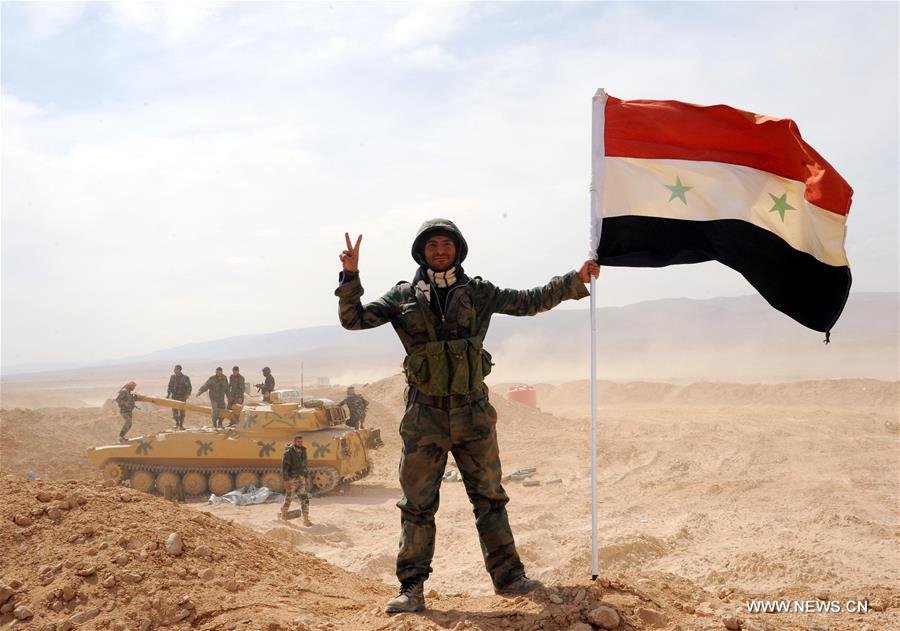På trods af krænkelser af våbenhvilen, så er kamphandlinger i det meste af områderne i Homs, Hama and Aleppo provinserne blevet afsluttet. Denne situation har gjort det muligt for civile indbyggere at vende tilbage til deres huse.
Takket været våbenhvileaftalen underskrevet af væbnede oppositionsgrupper, så har regeringsstyrkerne kunne intensifisere kampen imod IS og Jabhat al-Nusra terrorist grupperinger.
Formationer og enheder af den syriske hær såvel som militante enheder og formationer af den patriotiske oppositition har regrupperet siden starten af Marts for at udføre offensive handlinger imod IS terror grupper tæt ved Tadmur (Palmyra, Homs provinsen).
Unik footage: Mi-28N lancerer en guided antitank missil tæt ved Palmyra
Kommentar: Denne artikel er blot delvis oversat til dansk af sott.net fra: Russian MOD reveals Palmyra op details: City fully retaken, all 4000 Daeshbags killed
Before the occupation in May 2015 by ISIS Tadmur had been a tourist and trade center of Syria and presented an important trade and transport junction as well as that of oil and gas pipelines. To the south-west from the city there are ruins of antique Palmyra, which is the historical and cultural heritage of humanity.
The liberation of Palmyra was of strategic importance due to its location in the central part of Syria with a developed road system to all country regions: Damascus, Homs, Hama, Aleppo, al-Raqqah, Deir ez-Zor as well as to oil and gas fields (Jazal and Shaar) and to other fields of natural resources in neighboring areas.
By March, illegal armed groups have concentrated near Palmyra more than 4000 fighters, at least 25 tanks and MICVs, more than 20 units of bombardment and rocket artillery, more than 40 mortars, about 100 antitank guided missile systems and more than 50 cross-country vehicles with mounted heavy armament. Moreover, terrorists possessed more than 10 trucks rigged with explosives controlled by suicide bombers as well as UAVs.
ISIS terrorists installed the system of obstacles around Tadmur, which includes several levels of defence as well as defensive posts, firing points equipped on the heights, and control centres.
Russian servicemen and military councilors took direct part in planning the military operation in Palmyra.
After the task force had been formed, the Syrian troops supported by Russian Aerospace Forces started offensive operation on operational direction "Palmyra" on March 6. In course of the first stage of the operation main transportation routes around Tadmur have been blocked.
Terrorists' positions were attacked systematically by artillery and aviation of the Syrian government troops.
Aircraft of the Russian Aerospace Forces actively supported units of the Syrian army and militia.
In the course of March 7-27, in the interests of units of the Syrian government troops, the Russian Aerospace Forces have carried out more than 500 combat sorties near Palmyra performing more than 2000 airstrikes on ISIS terrorists.
Airstrikes by Russian Aerospace Forces agaisnt manpower and infrastructural objects of terrorists near PalmyraFirst of all the main strong points and artillery positions on heights have been eliminated.
Most control centres of militants were eliminated by the Russian aviation during the first two days of the operation.
Daily the Russian aviation eliminated the automobile columns with militants and ammunition that tried to force Palmyra from Al-Raqqah and Deir ez-Zor.
On March 23, units of the Syrian army came close to Palmyra and began to storm the high points in the city suburbs. They had been captured within 24 hours.
In the morning of March 27, the Syrian army and militia groups took control over the city. It took 2 days to liquidate the rest ISIS military groupings in some city districts.
During the operation, Russian aircraft attacked only detected objects of terrorists. The most important objects of terrorists were eliminated withy high-accurate munitions, which had been aimed at the targets from the ground in the real time mode.
It is to be stressed that not a single historical object of Palmyra suffered from actions of the Russian Aerospace Forces.
All the ISIS illegal armed groups that escaped from encirclement were destroyed by the Russian aviation which did not let them go towards al-Raqqah and Deir ez-Zor.
Regained control of the Syrian army over Palmyra will impede redeployment of the ISIS military groups between northern and southern areas of Syria. Moreover, it will allow reducing their defensive capabilities in Damascus and Aleppo.
Loss of control over rich natural resources will aggravate terrorists' economic and financial condition, reduce their capability for buying new weapons, ammunition, material means and supplying fighters with money.
In accordance with the decree of the President of the Russian Federation, Russian experts from the International Mine Action Center of the Armed Forces will arrive to Palmyra to clean it off highly explosive objects in the short terms.
The first units of Russian sappers have already arrived in Syria.
According to preliminary estimations, more than 180 hectares of the architectural, historical and inhabited parts of the city should be cleared of mines.
The work is complicated by the fact that apart from regular mines terrorists left behind in Palmyra a large number of improvised explosive assemblies. Therefore the most difficult areas will be cleared by Russian specialized robot-engineers Uran-6.




Kommentar: Yderligere læsning: Syrian forces clear ISIS out of Palmyra - RT reports from 'Pearl of the Desert' (VIDEOS)